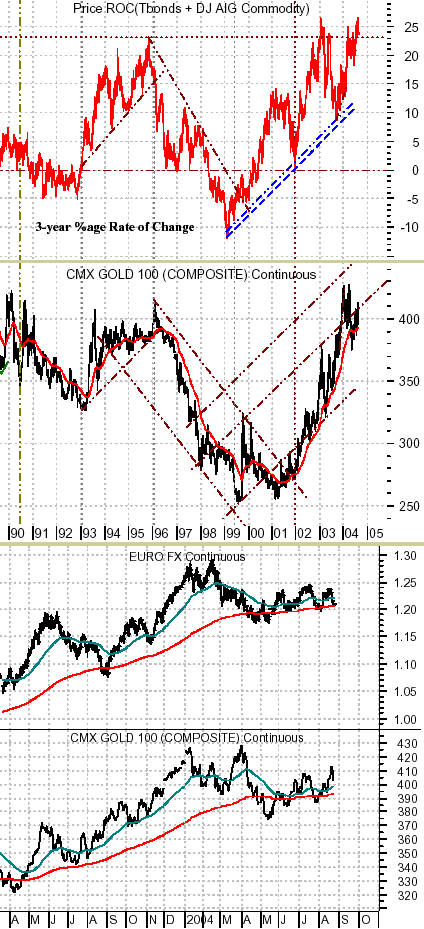.
|
|||
Chart Presentation: Golden IssuesInter-Market Relationships
Analysis
We start off with a comparative view of gold futures and a 3-year percentage Rate of Change indicator for the sum of the U.S. 30-year T-Bond futures and the DJ AIG Commodity Index. Why a 3-year Rate of Change? No particular reason other than the 'fit' between it and the price of gold is almost perfect. The swings up and down on the chart by both the indicator and gold futures makes the case that there is a general relationship between gold and both the bond and commodity markets. In the past we have argued that gold is half-money and half-commodity. It serves as a store of value on the one hand and as a raw material on the other. Gold tends to be early in the commodity cycle and often peaks just as some of the latecomers (like coffee) start to show strength. The next chart shows gold futures and the euro. On virtually a daily basis now the price of gold is responding both positively and negatively to small directional changes in the euro versus the dollar. We use the euro specifically here but both the Swiss franc and the British pound would likely serve as well. We have commented (quite often, actually) that the rise in the euro went with both stronger bond and commodity prices. Since both tend to impact the price of gold the argument leaps from the euro all the way to gold. In other words, as long as the euro is trading roughly sideways both the bond and commodity markets should remain relatively flat and this will also serve to contain the price of gold within the general trading range that has been formed over the past 8 or so months. One can argue that gold has become irrelevant as an investment class and that it no longer serves as a useful safe haven in times of crisis while others would argue that central banks and bullion banks are artificially suppressing its price. From an intermarket perspective, however, it is anything but irrelevant in that it serves as one of the most useful and sensitive conduits between the various markets. Gold trends with the European currencies and the commodity markets, is impacted by the trend in both short and longer-term interest rates, moves up and down versus base metals prices, and helps us as we try to 'time' the trends in other commodities. For today, however, the basic point is merely that the near and intermediate- term future for gold rests with the trends of the euro and the dollar. To be bullish on gold one has to necessarily be bullish on the euro and bearish on the dollar. Kevin Klombies
Editor/Publisher All Rights Reserved, 2004. IMRA subscriptions
are available for U.S.$49 per month (Cdn$74 +GST), payable quarterly. |

 We wanted to
return to gold today.
We wanted to
return to gold today.